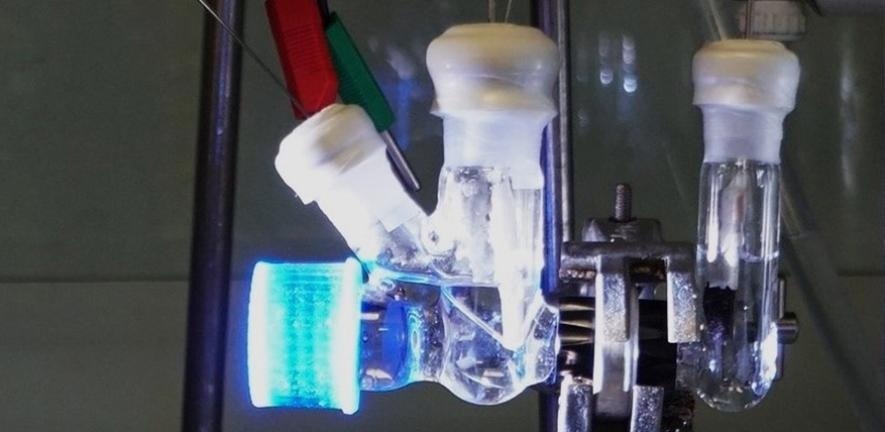Scientists have shown how carbon dioxide can be collected from industrial processes—or even directly from the air—and converted into clean, sustainable fuels using just solar energy.
 Carbon capture from the air and its photoelectrochemical conversion into fuel with simultaneous waste plastic conversion into chemicals. Image Credit: Ariffin Mohamad Annuar
Carbon capture from the air and its photoelectrochemical conversion into fuel with simultaneous waste plastic conversion into chemicals. Image Credit: Ariffin Mohamad Annuar
The Cambridge researchers created a solar-powered reactor that converts trapped CO2 and plastic waste into sustainable fuels and other useful chemical products. CO2 was turned into syngas, a vital element of sustainable liquid fuels, and plastic bottles were transformed into glycolic acid, which is widely utilized in the cosmetics industry.
In contrast to previous testing of their solar fuel technology, the researchers used CO2 from real-world sources, such as industrial exhaust or the air itself. The researchers were successful in capturing and concentrating CO2 and converting it into a sustainable fuel.
Although more work is needed before this technology can be employed on a large scale, the findings, published in the journal Joule, are a major step toward the generation of clean fuels to power the economy without the use of environmentally harmful oil and gas extraction.
Professor Erwin Reisner’s research group at the Yusuf Hamied Department of Chemistry has been employing artificial leaves for several years to generate sustainable, net-zero carbon fuels driven by photosynthesis (the process by which plants convert sunlight into food). Using only the power of the sun, these artificial leaves transform CO2 and water into fuels.
To date, their solar-driven experiments have employed pure, concentrated CO2 from a cylinder. Still, the technology must be capable of actively capturing CO2 from industrial processes or straight from the air to be viable. However, because CO2 is only one of many molecules in the air, developing a technology that is sensitive enough to convert very diluted CO2 is a major technical challenge.
We’re not just interested in decarbonization, but de-fossilization—we need to completely eliminate fossil fuels in order to create a truly circular economy. In the medium term, this technology could help reduce carbon emissions by capturing them from industry and turning them into something useful, but ultimately, we need to cut fossil fuels out of the equation entirely and capture CO2 from the air.
Erwin Reisner, Professor, Yusuf Hamied Department of Chemistry, University of Cambridge
The scientists were inspired by carbon capture and storage (CCS), which involves capturing CO2 and then pumping and storing it underground.
CCS is a technology that’s popular with the fossil fuel industry as a way to reduce carbon emissions while continuing oil and gas exploration. But if instead of carbon capture and storage, we had carbon capture and utilization, we could make something useful from CO2 instead of burying it underground, with unknown long-term consequences, and eliminate the use of fossil fuels.
Erwin Reisner, Professor, Yusuf Hamied Department of Chemistry, University of Cambridge
The researchers updated their solar-driven device to work with flue gas or directly from the air, turning CO2 and plastics into fuel and chemicals using the sun’s power.
By bubbling air through an alkaline solution-containing system, CO2 is selectively retained while other gases present in the air, like nitrogen and oxygen, harmlessly bubble out. The researchers may use this bubbling technique to concentrate CO2 from the air in a solution, making it easier to deal with.
A photocathode and an anode are included in the integrated system. On one side of the system is a captured CO2 solution that is transformed into syngas, a simple fuel. Plastics, on the other hand, can be transformed into valuable chemicals using just sunlight.
The plastic component is an important trick to this system. Capturing and using CO2 from the air makes the chemistry more difficult. But, if we add plastic waste to the system, the plastic donates electrons to the CO2. The plastic breaks down to glycolic acid, which is widely used in the cosmetics industry, and the CO2 is converted into syngas, which is a simple fuel.
Dr Motiar Rahaman, Study Co-First Author, University of Cambridge
“This solar-powered system takes two harmful waste products—plastic and carbon emissions —and converts them into something truly useful,” notes co-first author Dr Sayan Kar.
“Instead of storing CO2 underground, like in CCS, we can capture it from the air and make clean fuel from it. This way, we can cut out the fossil fuel industry from the process of fuel production, which can hopefully help us avoid climate destruction,” details Rahaman.
Kar adds, “The fact that we can effectively take CO2 from air and make something useful from it is special. It’s satisfying to see that we can actually do it using only sunlight.”
The researchers are currently developing a bench-top demonstrator device with better efficiency and practicability to demonstrate the benefits of combining direct air capture with CO2 utilization as a route to a zero-carbon future.
The study was funded in part by the Weizmann Institute of Science, the European Commission Marie Skłodowska-Curie Fellowship, the Winton Programme for the Physics of Sustainability, and the Engineering and Physical Sciences Research Council (EPSRC), part of UK Research and Innovation (UKRI).
Erwin Reisner is a Fellow at St John’s College, Cambridge, while Motiar Rahaman is a Research Associate. Erwin Reisner is the head of the Cambridge Circular Plastics Centre (CirPlas), which strives to minimize plastic waste by combining big ideas with practical solutions.
Journal Reference:
Kar, S., et al. (2023) Integrated capture and solar-driven utilization of CO2 from flue gas and air. Joule. doi.org/10.1016/j.joule.2023.05.022.